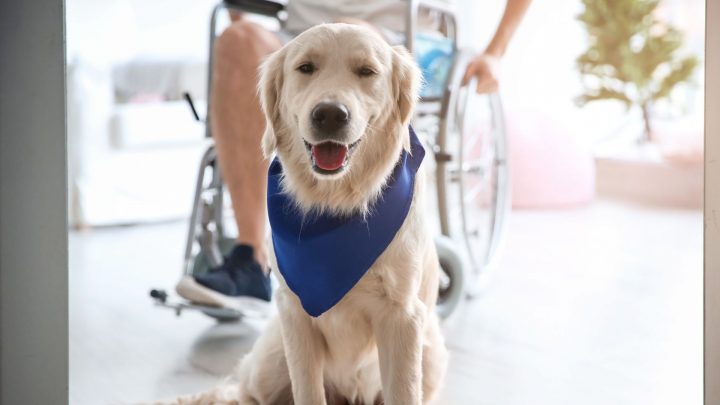Want your pet to become a Service or Therapy Animal in the USA? This blog will help you understand the needs, training, and requirements.

Table of Contents
- Helping Your Pet Become a Therapy or Service Animal
- The Difference Between Service Animals and Therapy and Emotional Support Animals
- Training & Registering Your Service or Support Animal
- What Next?
- FAQs
Helping Your Pet Become a Therapy or Service Animal
Many of us have been spending more time at home due to the coronavirus, COVID-19, and Stay-at-Home orders in many states. Even though our fur babies don’t understand why, they are delighted that we can spend more time with them, get more exercise together and perhaps spend more time on the couch together.
If you’ve ever been curious, now could be the perfect time to learn more about what it takes for your pet become a therapy or service animal. I’ve put together this list of information, links and resources to help you investigate whether certifying your pet as a service or therapy animal is right for you.
The issues are complex and controversial. For one, there are guidelines and there are laws related to service animals. Some are suggested best practices while others are punishable under the law if you don’t follow them.
There are also several groups that regulate or have a vested interest. The American’s with Disabilities Act (ADA) represents the people who really need these animals and so they are active in ensuring the rights of disabled people to own and use them. But businesses are often frustrated and confused about the laws. Do they have to let any dog (or cat or lizard) in as an emotional support animal?
The U.S. Department of Justice has issued and recalled guidelines for service animals. Each state also makes their own laws about service animals. It can get sticky depending on where you live.
No matter where you live, its probably best to work with an agency or chapter in your home state to ensure you have the most updated and relevant information.
More on that below. But first, what is the difference between a service animal (as defined by the law) and an emotional support or therapy animal?

The Difference Between Service Animals and Therapy and Emotional Support Animals
As described by the Washington State Service Dog Association (WSSDA), service animals are used in many different ways by people with a variety of disabilities. Service animals may lead blind people or serve as the ears of a deaf person. They may carry and pick up items, be used for balance, and provide warnings of impending seizures or low blood sugar. Service animals may allow people with anxiety disorders, Post Traumatic Stress Disorder (PTSD) or other emotional illnesses to function in society, by alerting their handlers to avoid anxiety triggers, by recognizing and blocking behaviors, or by stimulating the person to “snap back” to a conscious state. Service animals can remind handlers that it is time to take medication and can summon help in the case of fainting or a seizure.
The work or tasks performed by a service animal must be directly related to the individual’s disability.
As you can see, the human must have a diagnosed disability for their animal to qualify as a service animal. So while some animals provide emotional support for anxiety or PTSD for example, they do not become a service animal until the human is diagnosed with a disability. So unless you have a disability, or you are training your animal to be given away or sold to someone with a disability, your pet is not a “service animal.”
The ways that people with disabilities use service animals continues to grow and evolve. At present, only dogs and miniature horses are considered service animals some states. Many organizations discourage or forbid the use of primates, wildlife and exotic animals as service animals.
Although they serve a very important function, non-service animals, which include emotional support animals, comfort animals and therapy animals, are not technically service animals under some state laws. Other species of animals, whether wild or domestic, trained or untrained, are not considered service animals either.
The key difference is also training. The Americans With Disabilities Act (ADA) allows the handler of a service dog to access public spaces with that dog. For example, Washington state law has no requirement for a service dog to be certified, registered or otherwise identified as such. However, a service dog is required by Washington State law to be appropriately trained for this work.
Under the ADA, a handler simply needs to state that the dog is a service animal, and access should be granted. Many handlers prefer the convenience of having a dog registered–an identification tag, vest or cape is often provided to show the dog is a registered service animal. This can save the handler from having to disclose details of their disability. It does not matter if a person has a note from a doctor that states that the person has a disability and needs to have the animal for emotional support. A doctor’s letter does not turn an animal into a service animal. Training does.
So any animal can be called an emotional support or therapy animal by anyone. But under the law, restaurants, businesses and public buildings do not have to allow a person to bring a support animal with them into public spaces. Only trained service animals are protected under this law.
It’s an important distinction because the law protects people who need a service animal as an accommodation for their disability, while the law does not protect emotional or therapy animal accommodations. You need to understand the difference. As of January 1, 2019, police can fine a person up to $500 for misrepresenting their emotional support or therapy animal as a service animal.
So if you’d like your pet to become an emotional support animal, therapy animal or comfort animal, no training or registration is required by law. However, we highly recommend you use positive reinforcement training with help from online resources or with a professional. If you’d like to give your pet the job of cheering people up in a nursing home, airport or other public space someday, you want your pet to be a ‘good citizen’ and behave well with others. Many of those private and public places only allow service animals so its important to understand and communicate clearly before bringing your animal with you.
Training & Registering Your Service or Support Animal
The first step is to find an appropriate source of training. Unless you are a professional dog trainer, you should consider working with one. Consult the directory of service therapy animal organizations like the Certification Council for Professional Dog Trainers to find a certified professional dog trainer near you. Many will provide you with a certificate of completion when your dog has achieved an appropriate level of training.
For example, Bellingham’s Embarking Dogs awards a Canine Good Citizen certification upon completion of five levels of puppy obedience training or specified skill level for older dogs. This certification would allow you the confidence to offer your dog as a therapy dog in a willing nursing home but it still does not qualify as a service animal under the law.
If you’d like to pursue true service animal status, perhaps the best approach is to choose a registry that can recommend a professional trainer and give you step by step guidance on how to achieve it. Registries include Service Animal Registry of America, the National Service Animal Registry and the United States Service Dog Registry. Some registries are free while others charge a fee. Each can walk you through the steps required to become registered. It is not a quick process, but now is an excellent time to invest in the process so you’ll be ready when public spaces open again.
If you aren’t training the dog to be given away or sold to a person with a disability, and instead you would just like to give your pet the job of bringing emotional joy to others, then you might check out organizations like Pet Partners. Nonprofit organizations like this one have Therapy Animal Programs that train and organize handlers and their animals. Each program has program requirements that you can work toward now from home. These requirements include things like adequate house training, minimum age and length of ownership to ensure the safety of those in the public. Many offer a free webinar that can be completed at home as a first step. You can even search by zip code to see if there are other volunteers in your area.

What Next?
Once you have some information, your pet has achieved an adequate level of obedience and you’re sure you’d like to make it official, you’re ready for the next steps.
Depending on the organization you choose, you likely need to complete a number of steps that might include:
- Taking a Handler Course. Luckily, some offer online courses that could be completed now while we’re staying at home.
- Animal Health Screening. You’ll need to demonstrate that your pet has all required vaccinations through a medical screening that is signed by your veterinarian.
- Pass an Evaluation. Most organizations require that you meet with an evaluator in person, often a volunteer in your area. The evaluator will take your pet through a simulated visit to ensure you’re both ready for a nursing home or school. There may or may not be a fee, depending on the organization. This step might need to wait until Stay-At-Home orders have been lifted.
- Complete an Application. This step helps you become officially registered and often requires a background check of the human. Fees vary. Once complete, you’ll likely receive a certificate that can be presented to managers as proof that you’re ready. You’ll also likely get tags or a vest that will help identify your pet as a therapy animal.
It is important to understand that in many states, that the handler of a service or therapy dog is responsible for the animal’s behavior and care while in any public place or private business. Additionally, a service (or therapy) animal can be refused entry to a state business or building if the dog initiates unwanted contact with members of the public. For example, a dog who jumps up on other people while working can be excluded from that space.
So even if you’re excited, take your time in each step of the process to be sure you and your animal are ready. But once you get there, you and your animal will have the chance to bring smiles and perhaps assistance to others. That truly is a wonderful thing.
We wish you luck and a deeper connection with your pet while on this journey. Stay safe and healthy.
FAQs
Emotional support dogs provide emotional comfort and companionship to individuals with mental health conditions, primarily in housing settings. Service dogs, on the other hand, are trained to perform specific tasks to assist individuals with disabilities and have extensive legal rights to access public spaces.
There are people who may attempt to pass off their pets as service dogs for various reasons. It’s important to focus on the behavior and training of the dog rather than making assumptions based solely on appearance.




